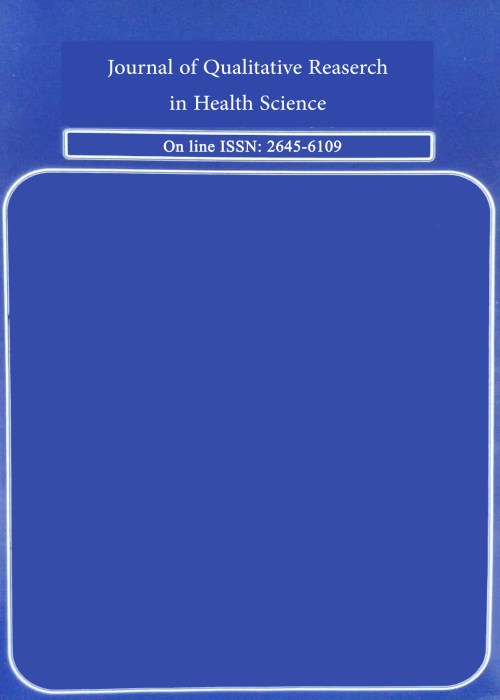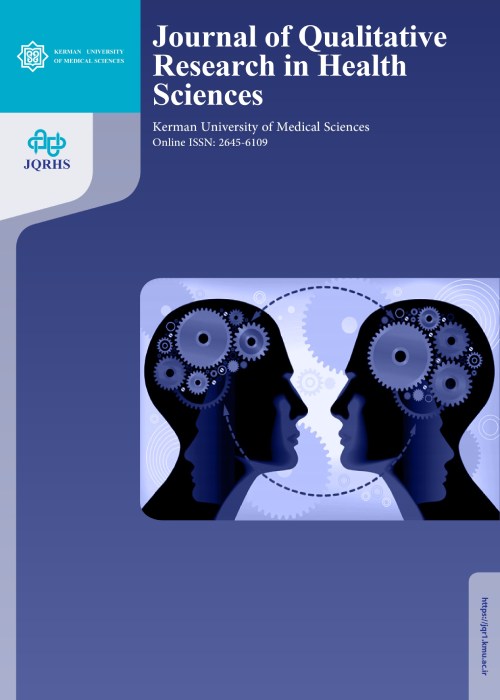فهرست مطالب

Journal of Qualitative Research in Health Sciences
Volume:12 Issue: 3, Autumn 2023
- تاریخ انتشار: 1402/08/10
- تعداد عناوین: 9
-
-
Pages 120-128BackgroundPatients with cancer are among the groups that are vulnerable to the COVID-19 crisis. Identifying the factors affecting the process of healthcare provision can improve the health services provided to cancer patients. Therefore, this study aimed to explain stakeholders’ perception of the healthcare services provided to cancer patients during the COVID-19 pandemic.MethodsThe present qualitative study was conducted using the conventional content analysis method in Iran in 2021. Participants included cancer patients, their families, and healthcare providers, who were selected via purposive sampling. Data were collected through 19 individual interviews and two focus groups and then analyzed using the method proposed by Graneheim and Lundman.ResultsQualitative data analysis revealed seven main categories, including the disruption of care continuity, reduced quality of health services, poor provision of community-based services, lack of comprehensive care, lack of public education, predicting changes in cancer incidence and mortality trends, and ethical challenges.ConclusionThe COVID-19 pandemic has exposed cancer patients to many challenges, including limited access to health services. Therefore, there is a need to facilitate these patients’ access to safe healthcare services.Keywords: COVID-19 pandemic, cancer patients, Healthcare delivery, Qualitative study
-
Pages 129-136BackgroundThe clinical learning environment is an important part of nursing education with a significant impact on nursing students’ perceptions and experiences. This study aimed to explore nursing students› reflections to determine the effects of the first rotation in the clinical learning environment of the oncology unit on their perceptions and practices.MethodsA descriptive qualitative study design was used. Data were collected using reflective diaries of forty 5th-semester nursing students about their experiences of learning in the oncology unit. Conventional content analysis was used for data analysis using MAXQD 10 software.ResultsParticipants’ perceptions of the clinical learning environment of the oncology unit were categorized into four main categories, namely challenging encounters, perceived needs, internal transcendence, and professional role development.ConclusionAccording to the results, nursing students’ unpleasant experiences must be managed. Careful attention should be devoted to the unique characteristics of this ward. Different educational strategies are needed, and clinical instructors must play their roles as facilitators in challenging conditions to promote nursing students’ clinical learning in oncology.Keywords: Oncology Nursing, Nursing students, Clinical education, Learning
-
Lived Experiences of Physicians Working in Hospitals during the COVID-19 Crisis: A Qualitative StudyPages 137-144Background
With the onset of the coronavirus pandemic in 2019, healthcare workers were at the forefront of dealing with the disease. Medical centers were faced with limited facilities and insufficient information. A number of medical staff became infected with the disease, and some lost their lives. This study was conducted to understand the perceived impact of the pandemic on physicians working in healthcare facilities of Shiraz and Yazd Universities of Medical Sciences during the COVID-19 pandemic.
MethodsThe present study was a qualitative one conducted in the teaching hospitals of Shiraz and Yazd in the southwest of Iran in 2020-2021. Purposive sampling was used to select the participants and the process continued until data saturation was reached. Data were collected through semi-structured interviews with 21 physicians working in hospital wards during the COVID-19 crisis. Data were analyzed using the seven-step analytical method proposed by Colaizzi.
ResultsFour themes and eleven subthemes emerged from data analysis. The main themes included managerial weakness, burnout, distorted doctor-patient relationship, and misinfodemic.
ConclusionThe preparedness of the medical system and the infrastructure needed to deal with the coronavirus pandemic were not as expected. The COVID-19 crisis also highlighted the lack of information and support for physicians as a significant challenge.
Keywords: COVID-19, physicians, Phenomenology, Crisis -
Pages 145-151BackgroundThe concept of adaptation has gained central importance in research on chronic diseases. However, this process is not clear in adult epileptic patients. This study aimed to explain the process of adaptation to disease in patients with epilepsy.MethodsThis study was conducted using the grounded theory approach from December 2018 to January 2020 in Isfahan, Iran. Data were collected by semi-structured interviews with 18 patients with epilepsy. Participants were selected by purposeful or theoretical sampling method. Data collection was performed by the first author through conducting semi-structured interviews. Data analysis was performed by Strauss and Corbin’s (1998) method.ResultsFour main categories with ten sub-themes were obtained from the data analysis. The main themes include “Perceived disorder,” “Scrimmage with the disease,” “Moving towards adaptation,” and “Balancing life.” The Core category achieved was “Trying to balance life.”ConclusionBased on the results, the process of adapting to epilepsy has four stages: “Perceived disorder,” “Scrimmage with the disease,” “Moving towards adaptation,” and “Balancing life.” The health providers’ awareness of these stages can provide a framework that can be used to help epilepsy patients achieve positive adaptation. Achievement of adaptation can help epileptic patients control the disease and improve their quality of life.Keywords: Epilepsy, Seizure, Adaptation, Adjustment, qualitative research, Grounded theory
-
Pages 152-158BackgroundNurses are an important part of the health system, and the effectiveness of their clinical education has a significant impact on community health. The clinical environment is constantly changing, making student education very stressful. Due to the negative effects of stressors on education, the present study was conducted to explain the stressors in the clinical environment.MethodsIn this qualitative study (content analysis), the participants were selected using the purposive sampling method. In-depth semi-structured interviews were conducted with 16 nursing students who had completed at least one semester of internship in Khalkhal University of Medical Sciences until data saturation was achieved. The data were coded, the related codes were classified into categories, and the main themes were extracted.ResultsFour categories were obtained in this study: personal problems, the interaction between students and patients, patients’ families, instructors, and ward staff, executive planning, and clinical education environment. The most important source of stress was personal problems, including a lack of awareness and fear of following some clinical guidelines. The lower-semester students were reported to have more stress than last-semester students.ConclusionDue to the many clinical stressors, the related authorities should be required to promote students’ professional development by identifying the clinical environment stressors and providing appropriate solutions to reduce and control them. In this regard, considering the role of instructors in reducing stress and facilitating student learning, providing educational programs to train instructors in this area can be one of the main steps to reduce student stress.Keywords: Stress, Clinical education, Nursing, qualitative research
-
Pages 159-165BackgroundParental disclosure is a phenomenon that occurs in families to a greater or lesser extent and has different effects on children and family relationships. Some parents do not know what topics are appropriate for disclosure and what the consequences may be. Therefore, the objective of the present study was to investigate the phenomenology of Iranian mothers› disclosure, its topics, and the experienced consequences.MethodsIn this qualitative study based on the descriptive phenomenological method, semi-structured interviews were conducted with a purposive sample of 22 first-marriage mothers who had disclosure experience and at least one 10- to 30-year-old child. The data were analyzed using Colaizzi’s phenomenological method.ResultsAnalysis of data revealed five main themes and 12 subthemes, including inappropriate disclosure topics (personal problems, problems with spouse), appropriate topics (positive or neutral comments about the spouse, financial problems, neutral and pleasant experiences, goals and viewpoints), contextual topics (negative comments about herself, communication problems with others, unpleasant experiences), positive consequences of disclosure (raising children’s awareness, improving the parent-child relationship quality), and negative consequences (undermining the parent-child relationship quality, creating negative emotions and thoughts in children). Mothers disclosed more frequently and about more diverse subjects to their children than their husbands.ConclusionIn general, the effects of mothers’ disclosure on children are different and depend on its content, and these effects are greater on adolescents. Family therapists, parent educators, and others who work with families can help mothers carefully evaluate their disclosures to establish clear and healthy communication boundaries with their children.Keywords: Phenomenology, Self-disclosure, Mother-child interaction, Financial disclosure, parenting
-
Pages 166-173BackgroundHealthcare providers in different countries have different experiences during epidemic conditions based on their nursing resources and healthcare systems and the cultural norms of the community. The present study aimed to explore the experiences of healthcare providers during the COVID-19 pandemic.MethodsThis qualitative study was conducted on 36 medical personnel from eastern Guilan in the north of Iran. The participants were selected via purposive sampling. The data were collected through semi-structured interviews. The interviews continued until data saturation. Data analysis was performed using conventional content analysis, simultaneous with data collection.ResultsData analysis revealed three main categories and 10 subcategories: peaceful coexistence (scientific-professional development, enhanced emotional proximity, and resilience in critical situations), the outburst of despair (exhaustion in clinical settings, annoying obsessions, ambivalent decision making, and excessive fear), and in the shadow of sorrow (the shadow of depression, painful public rejection, and in financial distress).ConclusionAn analysis of the participants’ experiences during the COVID-19 pandemic revealed three main themes: peaceful coexistence, the outburst of despair, and in the shadow of sorrow. Paying attention to the physical, psycho-social, emotional, and financial challenges and needs of healthcare providers, especially during the COVID-19 pandemic, is an undeniable necessity and requires the full attention and support of the authorities and the community.Keywords: Healthcare providers, Pandemic, COVID-19, qualitative research
-
Pages 174-180BackgroundThe most important element of education is the curriculum, which should fit the goals and tasks intended for each discipline. Counseling in midwifery has been established as an academic discipline in Iran since 2014 and, like other new disciplines, needs to be revised after five years. This study aimed to explain the challenges of theoretical and clinical courses offered in this field.MethodsThis study was conducted using a qualitative conventional content analysis of the data collected through interviews with professors, graduates, and master’s students of counseling in midwifery. The participants were 16 students of the master’s program in counseling in midwifery, 4 graduates of counseling in midwifery, and 7 professors in this field. In this study, the data were collected through focused group discussions and individual and face-to-face semi-structured interviews. Data analysis was performed using conventional content analysis.ResultsThe challenges revealed through the interviews with the counseling in midwifery students, graduates, and professors were “the need to empower professors,” “problems in providing an arena for clinical education,” “intermingling of counseling with sociocultural constructs,” “the need to update the curriculum,” “the unclear role of counseling in midwifery services in the health system,” and “standardization and expansion of the field.”ConclusionThis study showed that there are weaknesses in counseling education in midwifery that need to be addressed and corrected. It seems that the current curriculum cannot meet the educational and clinical needs of the students. Thus, the curriculum needs to be updated. Besides, some awareness-raising strategies should be adopted to make students and the public familiar with counseling in midwiferyKeywords: Clinical education, Theoretical education, Counseling in midwifery, content analysis, qualitative research
-
Pages 181-187BackgroundOne of the moral challenges in the healthcare system is discrimination in providing care to patients. The present study aimed to report the experiences of nursing instructors and students regarding discrimination in nursing care.MethodsThis qualitative study was conducted using conventional content analysis through semi-structured interviews with 8 nursing instructors and 13 nursing students. The participants were selected using the purposive sampling method. Data collection continued until data saturation. Data were analyzed using Graneheim and Lundman’s proposed method. Data collection and analysis were concurrent.ResultsAccording to the findings, “Discrimination paradigm,” “Discrimination as a negative concept,” and “The role of nursing instructors” (teaching moral values, being a role model, and evaluating moral standards) were identified as the main categories.ConclusionAccording to the results of this study, nursing instructors are recommended to introduce moral topics to students, act as role models for them, and teach them how to deal with ethical challenges.Keywords: content analysis, Discrimination, nursing care, Nursing instructors, Nursing students


